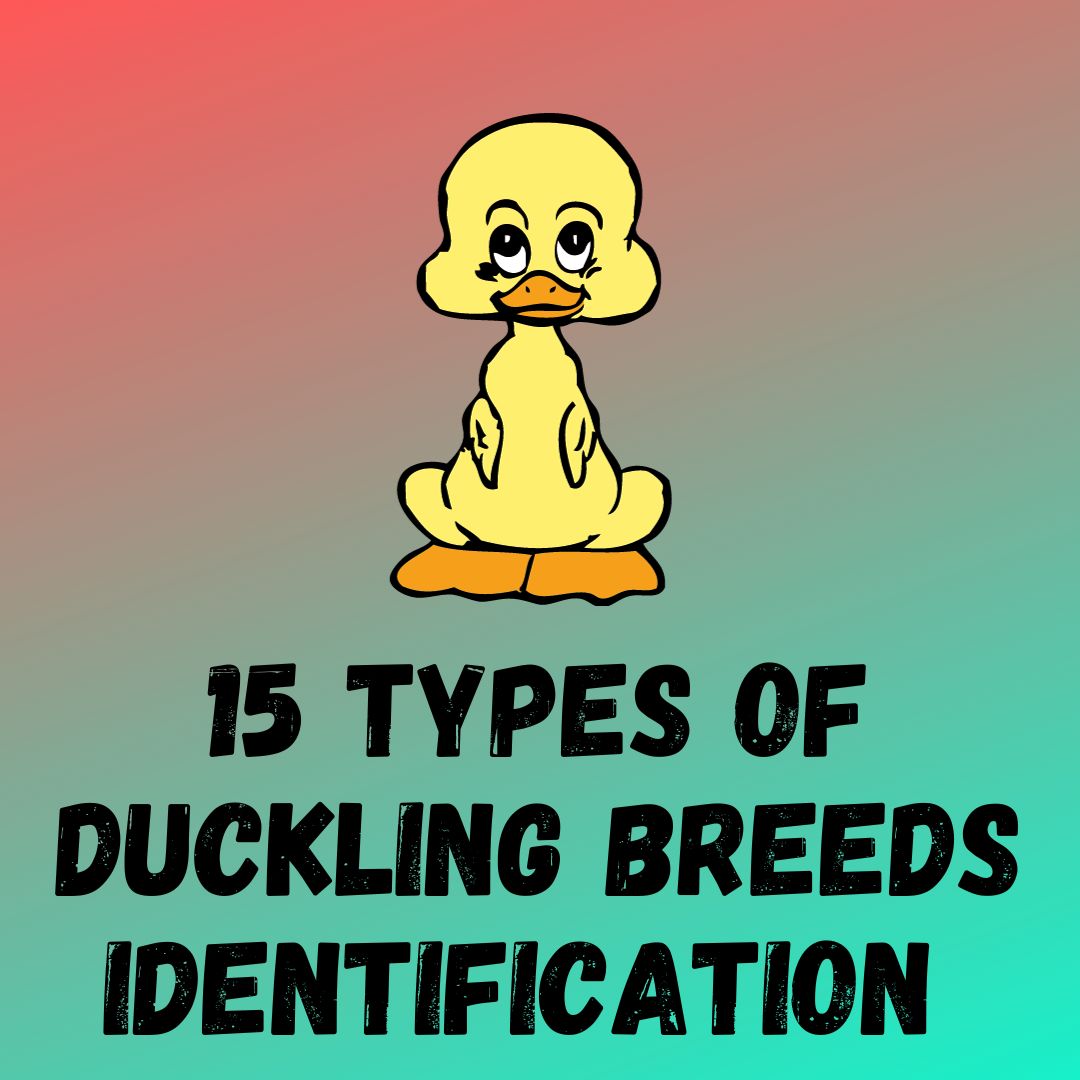Identifying different duckling breeds can be a fun and educational activity for poultry enthusiasts. While it might be challenging to identify duckling breeds solely based on appearance, especially when they are very young, there are some key characteristics and markings that can help with identification. Here’s a chart to assist in identifying various duckling breeds:
Please note that ducklings of the same breed can have slight variations in color and markings, so it’s important to consider these key characteristics collectively for accurate identification. Additionally, some ducklings may change in appearance as they mature into adults, so consulting a poultry expert or breed standards can be helpful for precise identification, especially if you plan to show your ducks.
Post Contents
- Identification features of ducks
- Duckling Breed Identification Chart
- The World of Ducklings: An In-Depth Introduction
- 1. Pekin Ducklings and Ducks
- 2. Mallard Ducklings and Ducks
- 3. Khaki Campbell Ducklings and Ducks
- 4. Rouen Ducklings and Ducks
- 5. Cayuga Ducklings and Ducks
- 6. Call Ducklings and Ducks
- 7. Buff Ducklings and Ducks
- 8. Saxony Ducklings and Ducks
- 9. Swedish (Blue Swedish) Ducklings and Ducks
- 10. Welsh Harlequin Ducklings and Ducks
- 11. Crested Ducklings and Ducks
- 12. Aylesbury Ducklings and Ducks
- 13. Orpington Ducklings and Ducks
- 14. Magpie Ducklings and Ducks
- 15. Runner Ducklings and Ducks
- Indian Runner Ducklings and Ducks
- 16. Muscovy Ducklings and Ducks
- 17. Appleyard Ducklings and Ducks
- 18. Swedish Duck / Blue Swedish Duck
- Leg Band and Color Identification of Day Old Ducklings
- Related FAQ’S
- Summary
Identification features of ducks
Ducks, like many bird species, can be identified based on a combination of physical characteristics, including size, plumage (feathers), bill shape, legs, and other specific traits. Here are some key identification features of ducks:
- Size: Ducks come in various sizes, ranging from small to large. This can help differentiate between different species. For example, teal ducks are smaller, while mallards are medium-sized, and swans are much larger.
- Plumage: Feather coloration and patterns are often crucial for identification. Pay attention to the color of the duck’s head, body, wings, and tail. Some ducks have distinctive markings or iridescent patches. For example, male mallards have glossy green heads.
- Bill Shape: The shape and size of the bill (beak) can be a key identifier. Some ducks have broad, flat bills for dabbling in the water, while others have narrow, pointed bills for probing in mud or catching fish.
- Leg Color: The color of a duck’s legs can vary, and it’s often species-specific. For example, mallards have orange legs, while wood ducks have bright red legs.
- Habitat: Ducks are often associated with specific types of habitats. For instance, you’ll find wood ducks in wooded wetlands and diving ducks in deeper bodies of water.
- Behavior: Observe the duck’s behavior. Some ducks, like dabblers, feed on the water’s surface, while diving ducks can disappear underwater for extended periods.
- Voice: Ducks have distinct vocalizations. While this might not help with initial identification, it can be a clue once you’re familiar with the sounds of various species.
- Season: The time of year can also provide clues. Some duck species are migratory and only present in certain regions during specific seasons.
- Geographic Location: Different duck species are found in various parts of the world. Knowing where you are can significantly narrow down the possibilities.
- Field Guides: Carrying a field guide specific to birds, including ducks, can be incredibly helpful. These guides typically include detailed illustrations and descriptions to aid in identification.
Duckling Breed Identification Chart
Identifying ducklings of specific breeds can be challenging, especially when they are very young, as they may not yet display all the characteristics of their adult counterparts. However, there are some key traits and markings that can help with identification. Here’s how to identify ducklings of the mentioned breeds:
| Duckling Breeds | Key Characteristics |
|---|---|
| Pekin Ducklings | – All white feathering. – Orange bill and orange legs. – Stout, round bodies. |
| Mallard Ducklings | – Yellow and brown mottled appearance. – Dark bill with an orange splotch. – Webbed feet. |
| Khaki Campbell Ducklings | – Khaki-colored feathers. – Dark bills and orange legs. – Long and slender bodies. |
| Rouen Ducklings | – Similar to Mallard ducklings but larger. – Mottled yellow and brown appearance. – Dark bill with an orange splotch. |
| Indian Runner Ducklings | – Upright stance. – Varying colors, including brown, black, and white. – Long, slender bodies. |
| Cayuga Ducklings | – Dark-colored, often black. – Dark bill and dark legs. – Feathers can have an iridescent green sheen. |
| Swedish Ducklings | – Blue-gray feathers. – Orange bills and orange legs. – Rounded bodies. |
| Welsh Harlequin Ducklings | – Light-colored with yellow and brown mottling. – Dark bill and orange legs. |
| Buff Ducklings | – Light buff-colored feathers. – Dark bill and orange legs. – Plump bodies. |
| Saxony Ducklings | – Various shades of brown and white. – Dark bills and orange legs. – Compact bodies. |
| Appleyard Ducklings | – White feathers with splashes of brown. – Dark bills and orange legs. – Medium-sized. |
| Muscovy Ducklings | – Can vary in color, including black, white, chocolate, and blue. – Unique appearance with facial caruncles. – Claws on webbed feet. |
| Crested Ducklings | – Any breed with a distinctive crest on the head. – Crests can vary in size and shape depending on the breed. |
| Call Ducklings | – Miniature ducks. – Various colors and patterns. – Small and compact bodies. |
Duckling Qualities in Detail
1. Precocial Development
- Ducklings hatch with their eyes open and are ready to walk and swim almost immediately.
- This ability enables them to follow their mother and explore their surroundings for food.
2. Social Behavior
- Ducklings are highly social and stick closely to their mother in a group.
- They can recognize their parents’ voices, which helps in forming a strong familial bond.
3. Fast Growth
- Within the first week, ducklings often double their weight, showcasing their swift development.
- This rapid growth highlights their evolutionary drive to adapt and thrive quickly.
4. Foraging
- They can forage for food, learning through trial and error what is safe to eat.
- Their foraging instincts are coupled with swimming skills for an efficient start to survival.
5. Dependence on the Mother
- Ducklings rely heavily on their mother for warmth, protection, and guidance.
- This dependence lasts around 50-60 days, until they fledge and can survive independently.
6. Adaptability
- Ducklings are naturally resourceful and adaptable, thriving in a variety of environments.
- Their communal nature supports their survival as they work together in a group.
The World of Ducklings: An In-Depth Introduction
Ducklings, the young of ducks, are fascinating creatures marked by their precocious nature, rapid growth, and diverse characteristics. Each breed has unique attributes that make it special. Below is an overview of various duckling types, their traits, and how to identify them.
1. Pekin Ducklings and Ducks
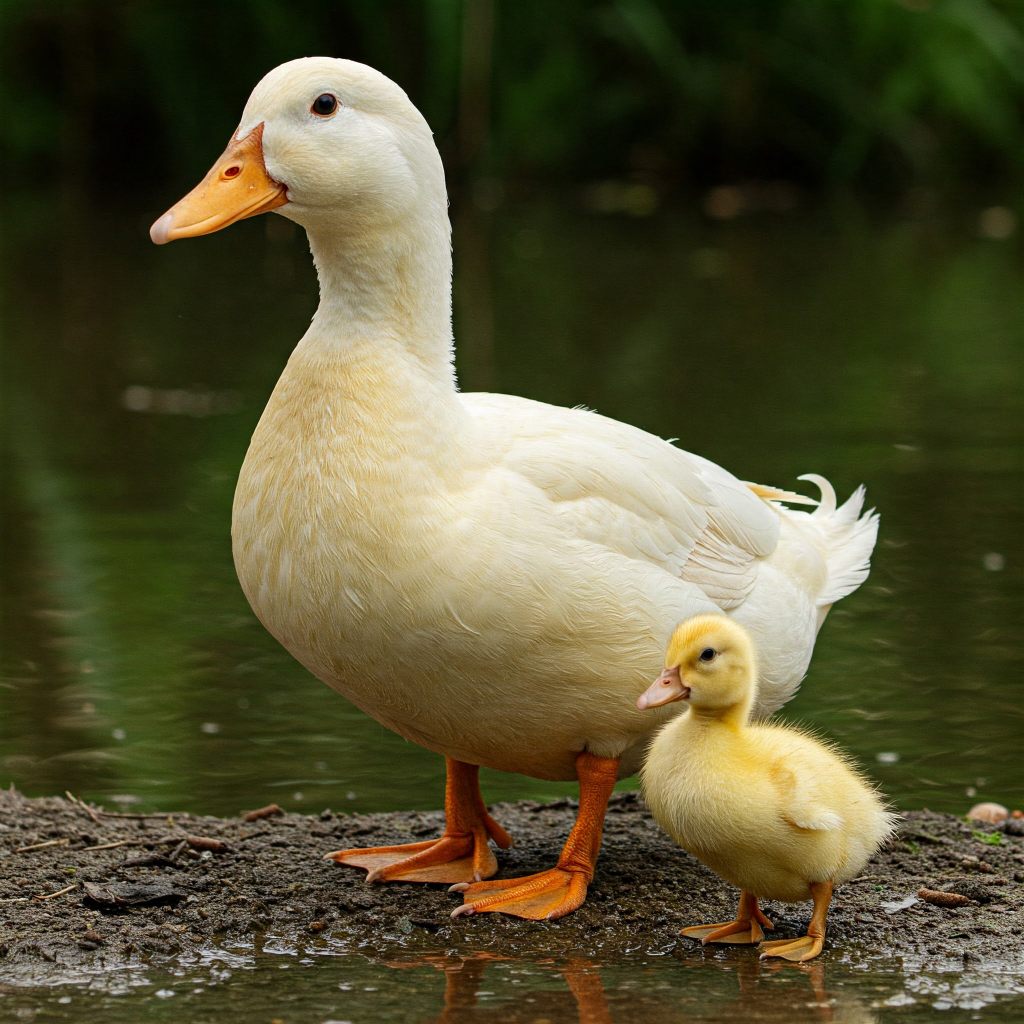
Identification:
- Ducklings: Bright yellow with chubby bodies, orange legs, and webbed feet. Their cheerful appearance makes them a favorite among children and hobbyists.
- Adults: Pure white feathers, large bodies, and vibrant orange bills and legs.
Traits:
Pekin ducks are adaptable, friendly, and calm. They grow rapidly, making them ideal for meat production. Known for their resilience, they thrive in various climates.
Fun Fact:
The Pekin duck is one of the most iconic domestic duck breeds and has even been featured in Hollywood movies.
2. Mallard Ducklings and Ducks
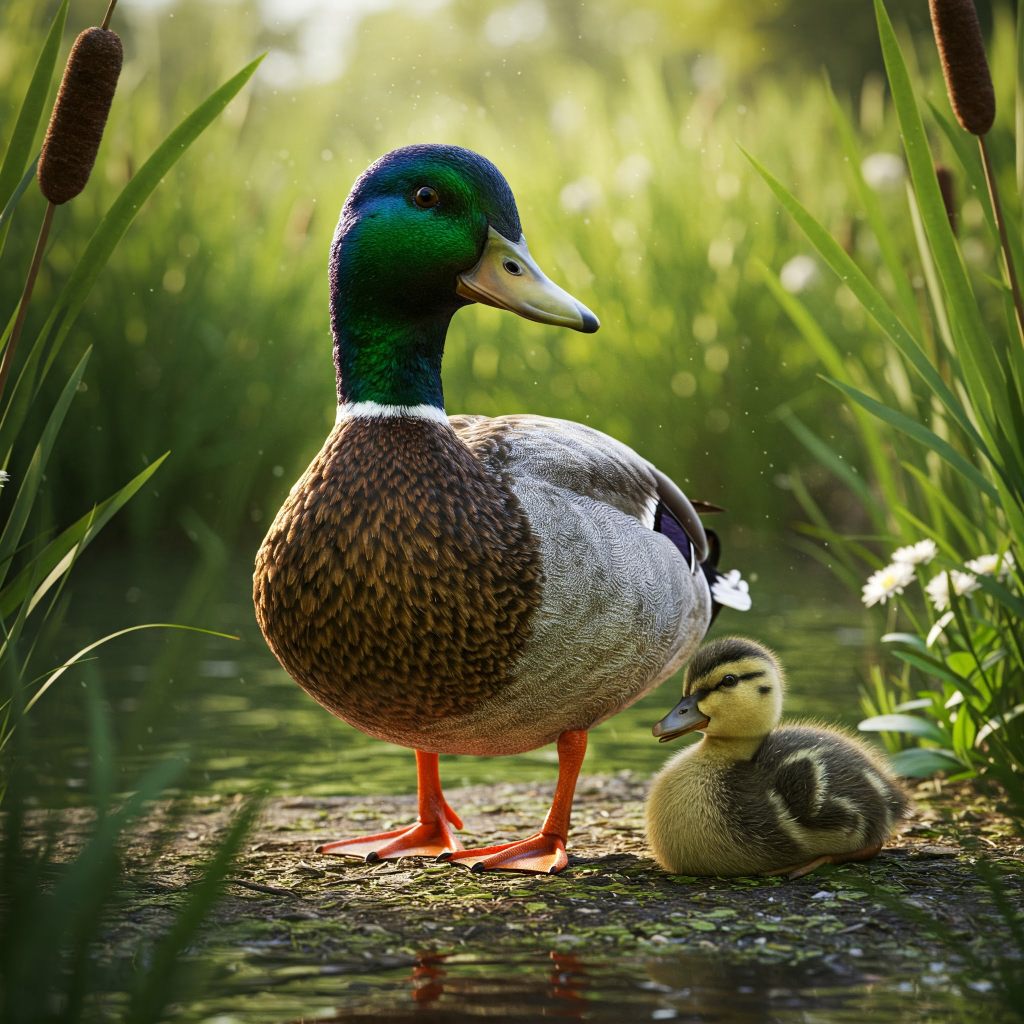
Identification:
- Ducklings: Yellow and brown with distinctive dark stripes running through their eyes, giving them a wild appearance.
- Adults: Males sport brilliant green heads, chestnut breasts, and blue wing patches, while females have mottled brown feathers for camouflage.
Traits:
Mallards are agile swimmers and adept at foraging. They can adapt to urban parks, rural ponds, and wetlands with ease.
Fun Fact:
Mallards are the ancestors of most domestic duck breeds, making them the genetic foundation for ducks worldwide.
3. Khaki Campbell Ducklings and Ducks
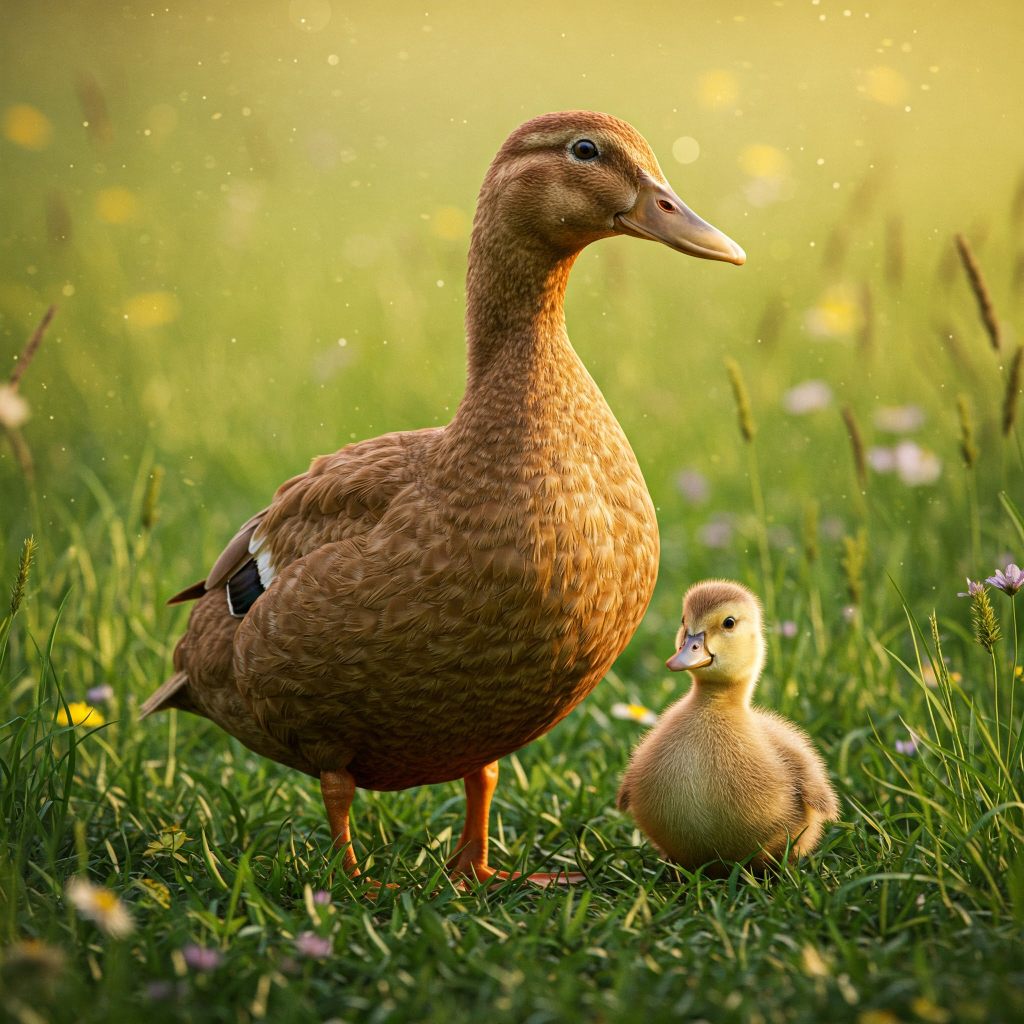
Identification:
- Ducklings: Khaki-colored with soft, streamlined fluff and dark beaks.
- Adults: Buff and brown feathers with a khaki undertone, a streamlined body, and alert posture.
Traits:
Khaki Campbell ducks are renowned for their prolific egg production, laying up to 300 eggs per year. They are active and thrive in free-range environments.
Fun Fact:
This breed was intentionally developed in England by Mrs. Adele Campbell to combine beauty with utility.
4. Rouen Ducklings and Ducks
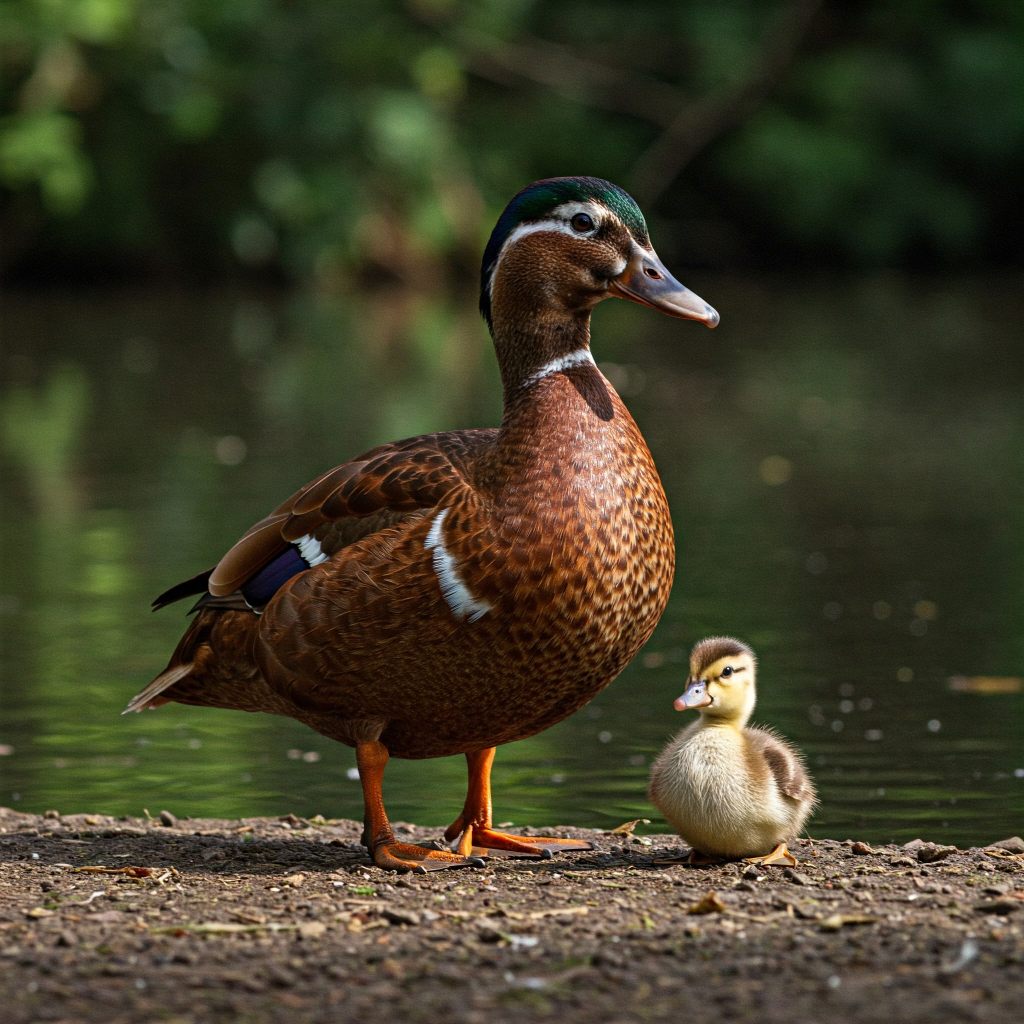
Identification:
- Ducklings: Larger than Mallards, with darker and richer brown patterns.
- Adults: Males resemble Mallards but are larger and have softer, richer tones.
Traits:
Rouens are docile and slow-maturing, making them popular for meat production and ornamental purposes.
Fun Fact:
Although they look similar to Mallards, Rouens are much heavier and slower, earning them the nickname “gentle giants.”
5. Cayuga Ducklings and Ducks
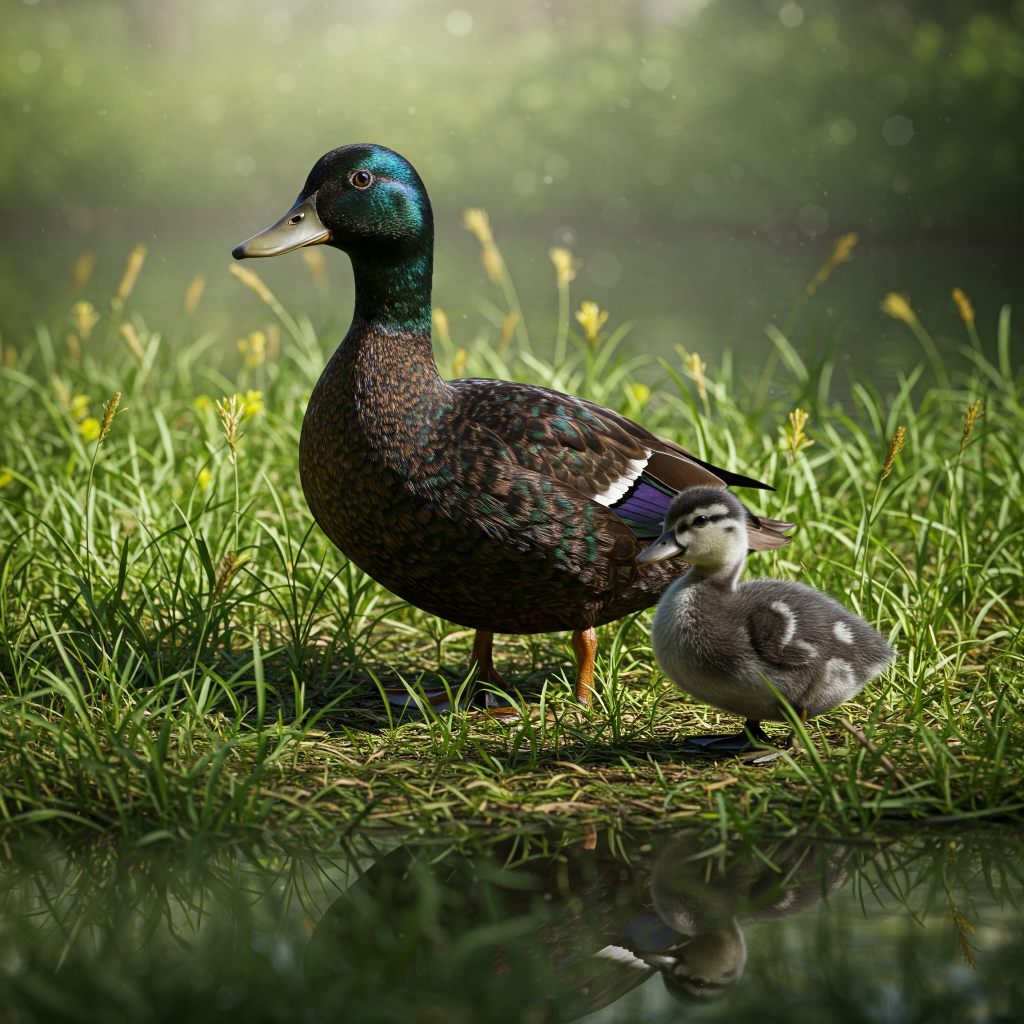
Identification:
- Ducklings: Black with a subtle green sheen under bright light.
- Adults: Stunning iridescent black feathers that shimmer green in sunlight.
Traits:
Cayugas are quiet and hardy, known for their beauty and unique eggs, which range from black to gray before lightening throughout the laying season.
Fun Fact:
This breed was named after the Cayuga Lake in New York, where it originated.
6. Call Ducklings and Ducks
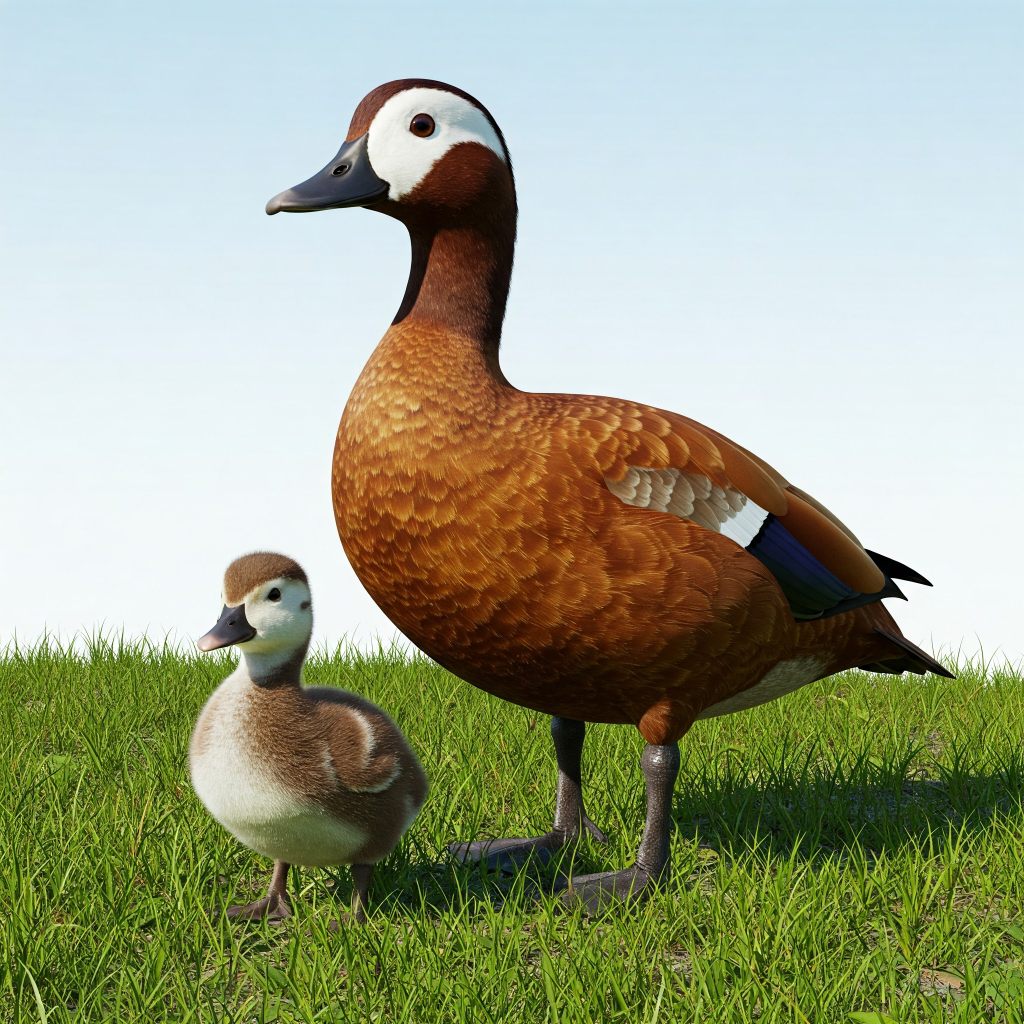
Identification:
- Ducklings: Tiny and fluffy, available in various shades including white and brown.
- Adults: Compact bodies with short bills and high-pitched voices.
Traits:
Call ducks are social, energetic, and primarily kept for ornamental purposes. Their petite size makes them ideal as pets.
Fun Fact:
Originally bred as decoys, their loud, distinctive calls were used to lure wild ducks during hunts.
7. Buff Ducklings and Ducks
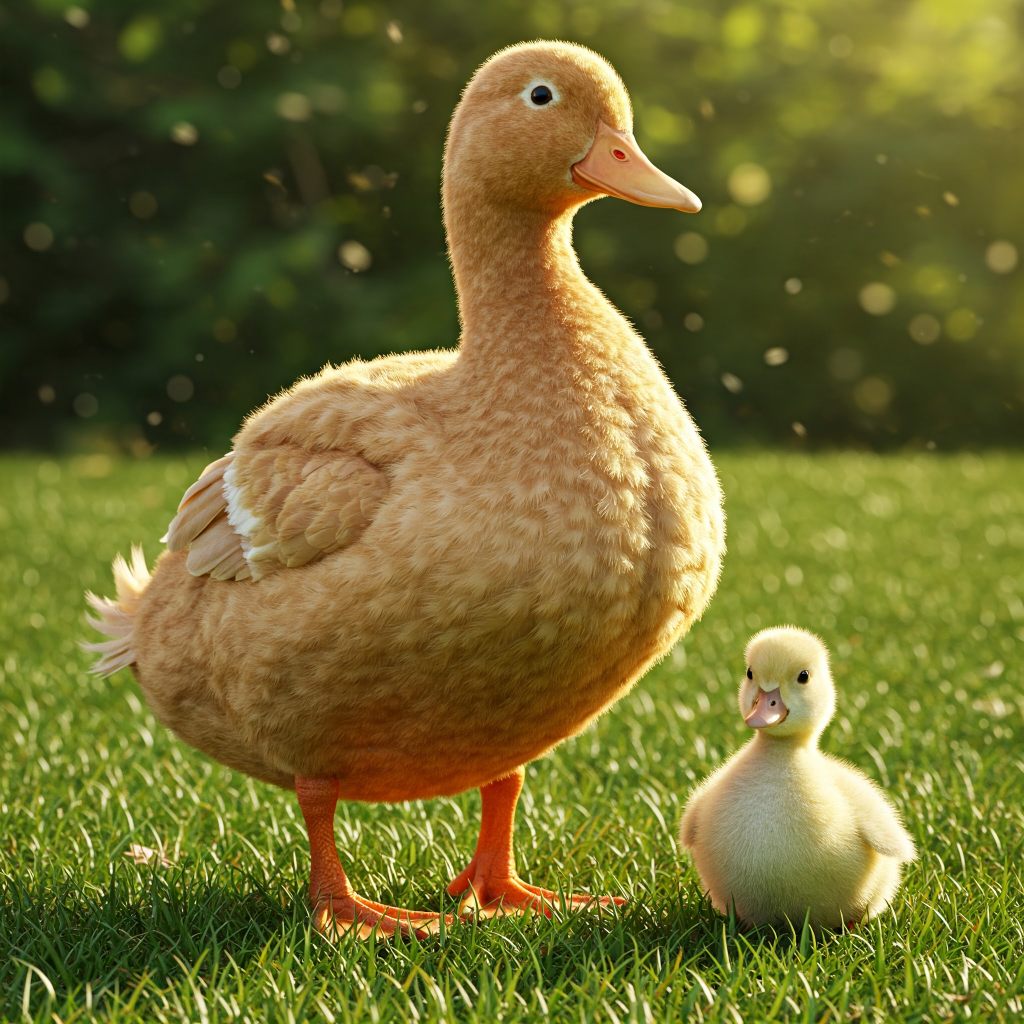
Identification:
- Ducklings: Soft buff-colored down with pale orange feet and beaks.
- Adults: Light buff plumage with a rounded build and calm demeanor.
Traits:
Buff ducks are versatile and resilient, making them great for egg production, meat, or as companions.
Fun Fact:
The Buff duck is an English breed known for its adaptability and mild temperament.
8. Saxony Ducklings and Ducks
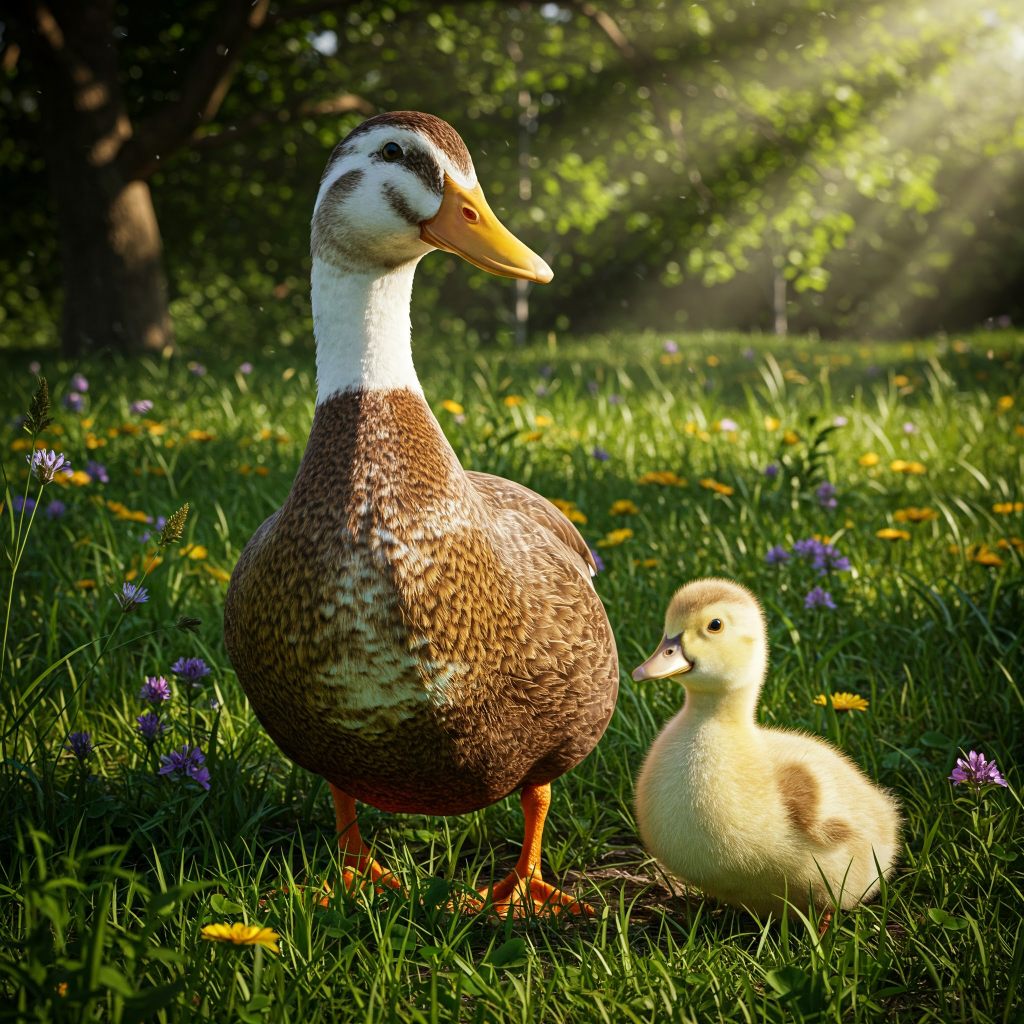
Identification:
- Ducklings: Yellowish-buff down with occasional brown streaks.
- Adults: Buff feathers with white accents and a robust physique.
Traits:
Saxony ducks are hardy and dependable, suitable for both meat and egg production. They are known for their calm disposition.
Fun Fact:
Saxony ducks were originally bred in Germany and nearly went extinct during World War II before their population was revived.
9. Swedish (Blue Swedish) Ducklings and Ducks
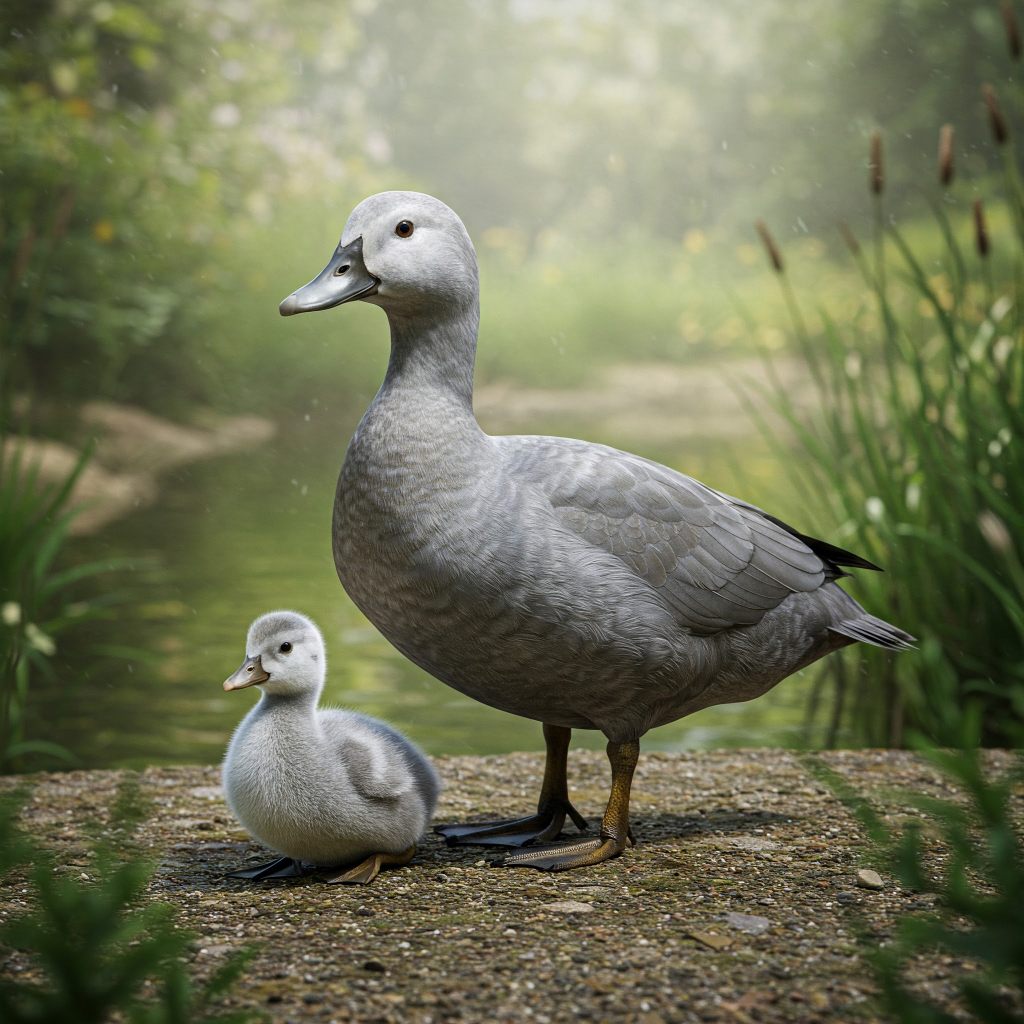
Identification:
- Ducklings: Blue-gray down with lighter patches and a distinct white bib.
- Adults: Blue feathers with white chest markings, occasionally appearing in black variations.
Traits:
Swedish ducks are hardy and suited for colder climates. Their beautiful plumage adds aesthetic value to any flock.
Fun Fact:
Blue Swedish ducks exhibit a fascinating genetic trait where only some offspring inherit their iconic blue coloring.
10. Welsh Harlequin Ducklings and Ducks
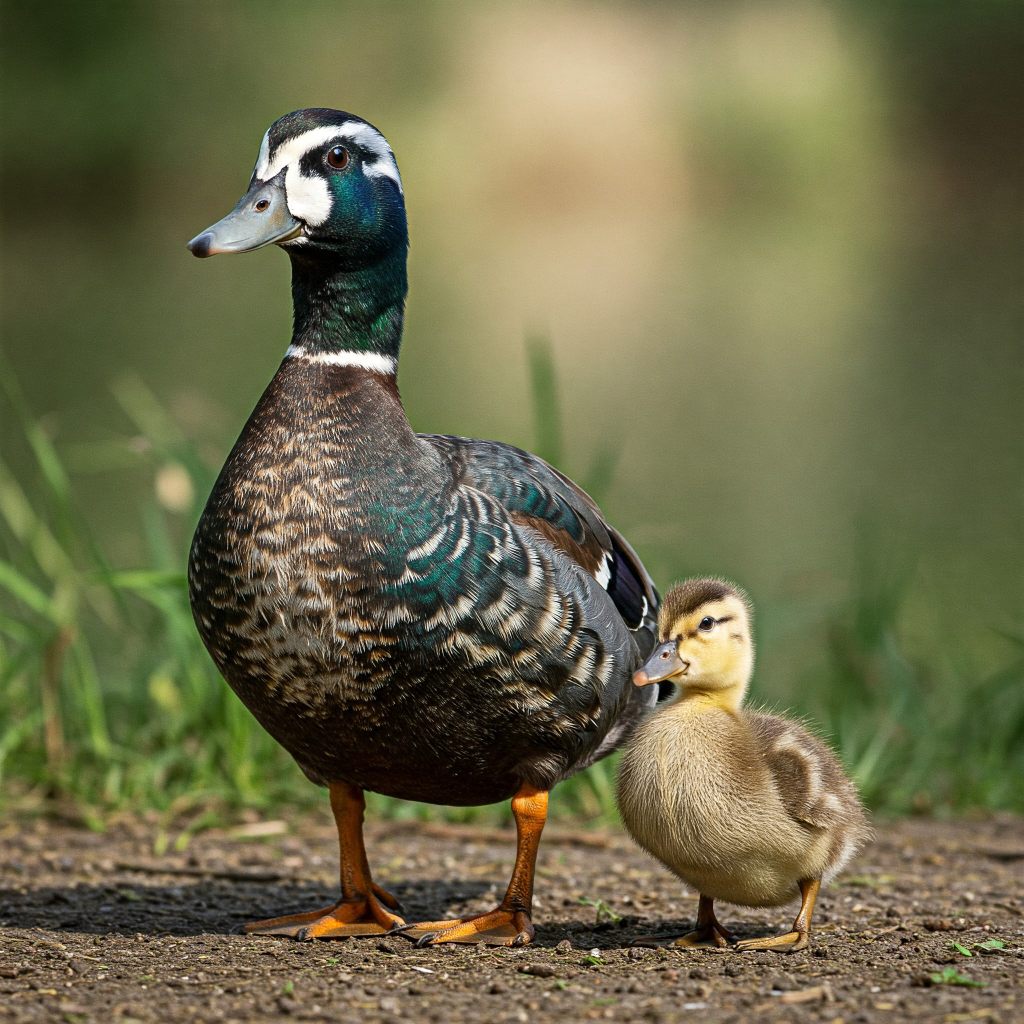
Identification:
- Ducklings: Yellow with light brown markings and an elegant appearance.
- Adults: Gold or silver plumage with intricate patterns on the wings.
Traits:
Welsh Harlequins are prolific egg layers with calm, friendly personalities. They are great for backyard flocks.
Fun Fact:
The breed was first developed in Wales in the 1940s and quickly became prized for its utility and beauty.
11. Crested Ducklings and Ducks
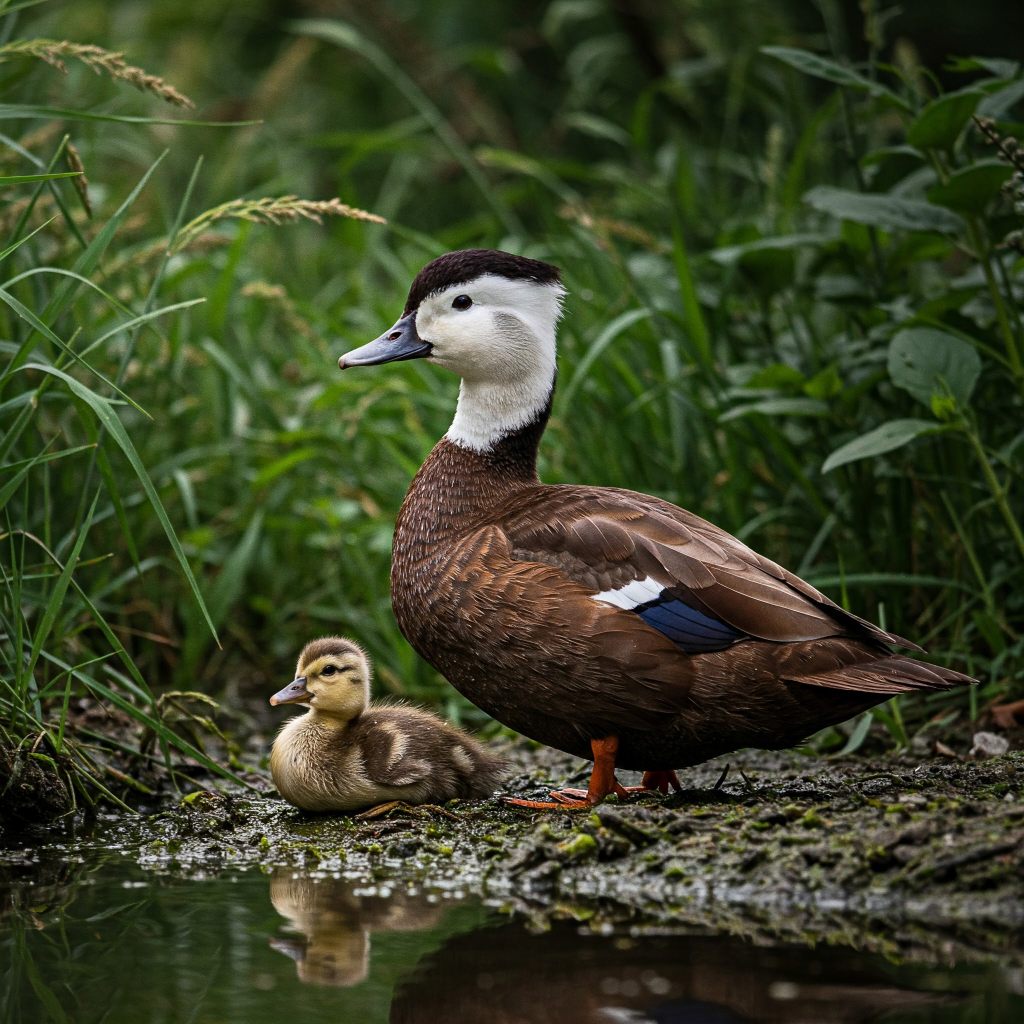
Identification:
- Ducklings: Yellow fluff with an adorable crest or tuft on their heads.
- Adults: Distinctive crests of feathers, available in various colors including white and black.
Traits:
Crested ducks are ornamental and playful. Their unique appearance makes them a standout in any flock.
Fun Fact:
The crest is the result of a genetic mutation, making each duck’s tuft unique.
12. Aylesbury Ducklings and Ducks
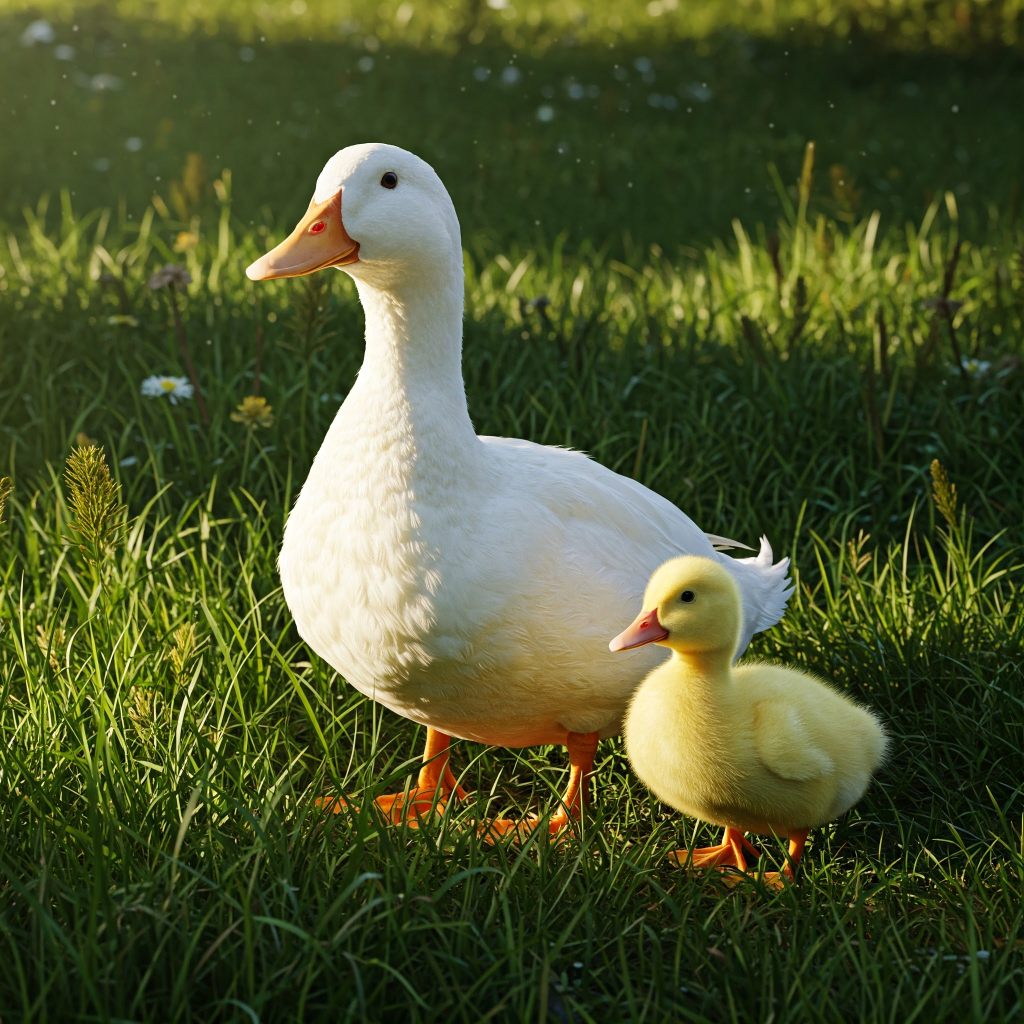
Identification:
- Ducklings: Yellow with pale pink bills and orange feet.
- Adults: White plumage with pink beaks and a hefty build.
Traits:
Aylesburys are excellent meat ducks and are known for their even temperaments.
Fun Fact:
This traditional English breed has been a staple of British cuisine for centuries.
13. Orpington Ducklings and Ducks
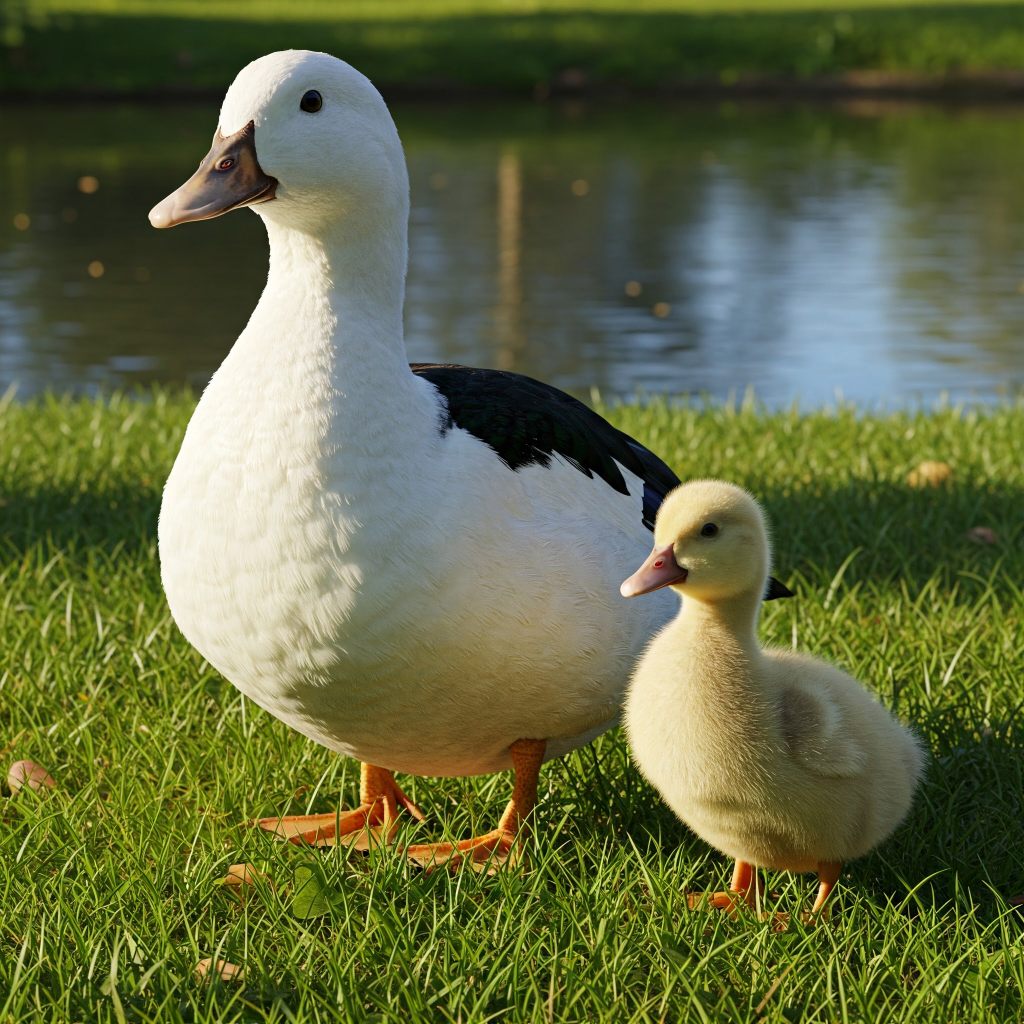
Identification:
- Ducklings: Buff or beige down with soft orange beaks.
- Adults: Rounded and elegant bodies with pale buff feathers.
Traits:
Orpington ducks are dual-purpose birds, excelling in both egg production and meat quality.
Fun Fact:
The Orpington duck was bred to rival the prolific Pekin in production.
14. Magpie Ducklings and Ducks
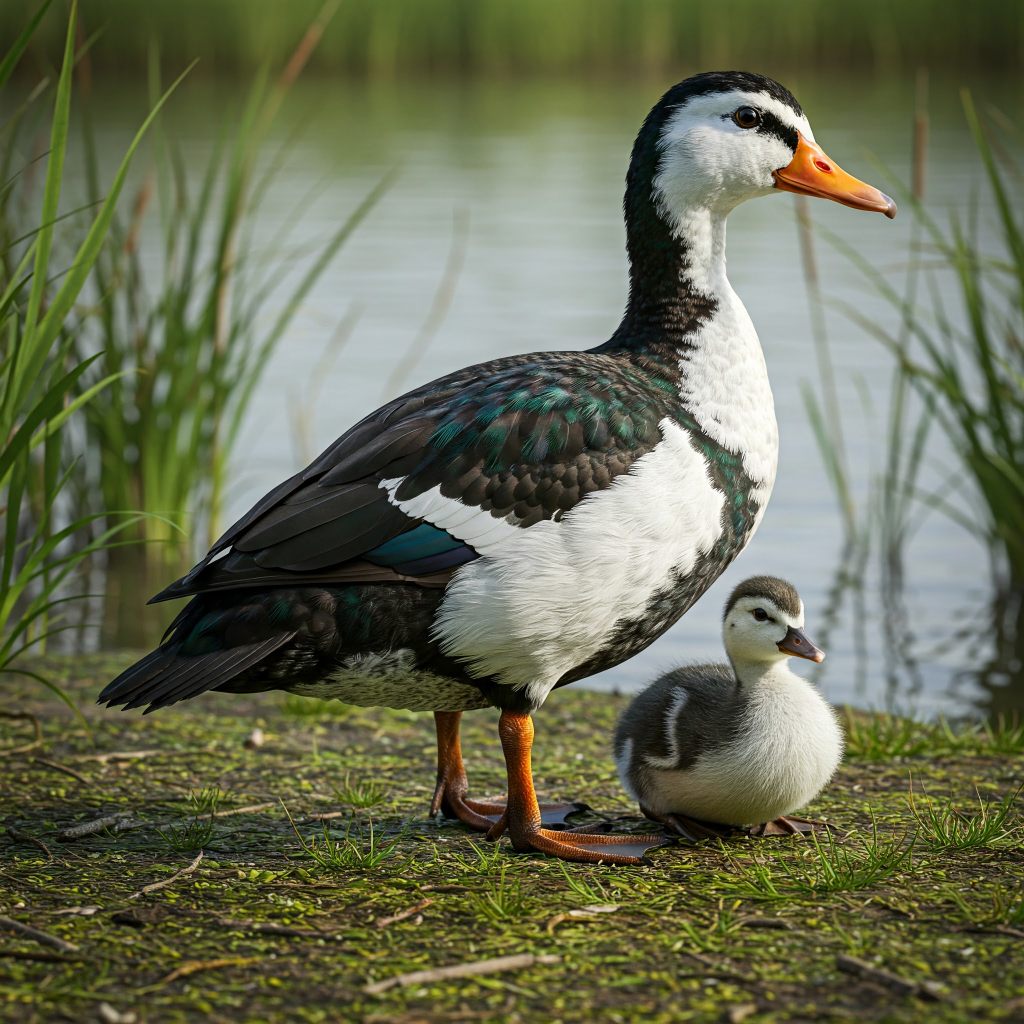
Identification:
- Ducklings: Yellow with black patches on the head and back.
- Adults: Striking black and white feather patterns.
Traits:
Magpies are active foragers, ideal for pest control and garden maintenance.
Fun Fact:
No two Magpie ducks have identical markings, adding to their charm.
15. Runner Ducklings and Ducks
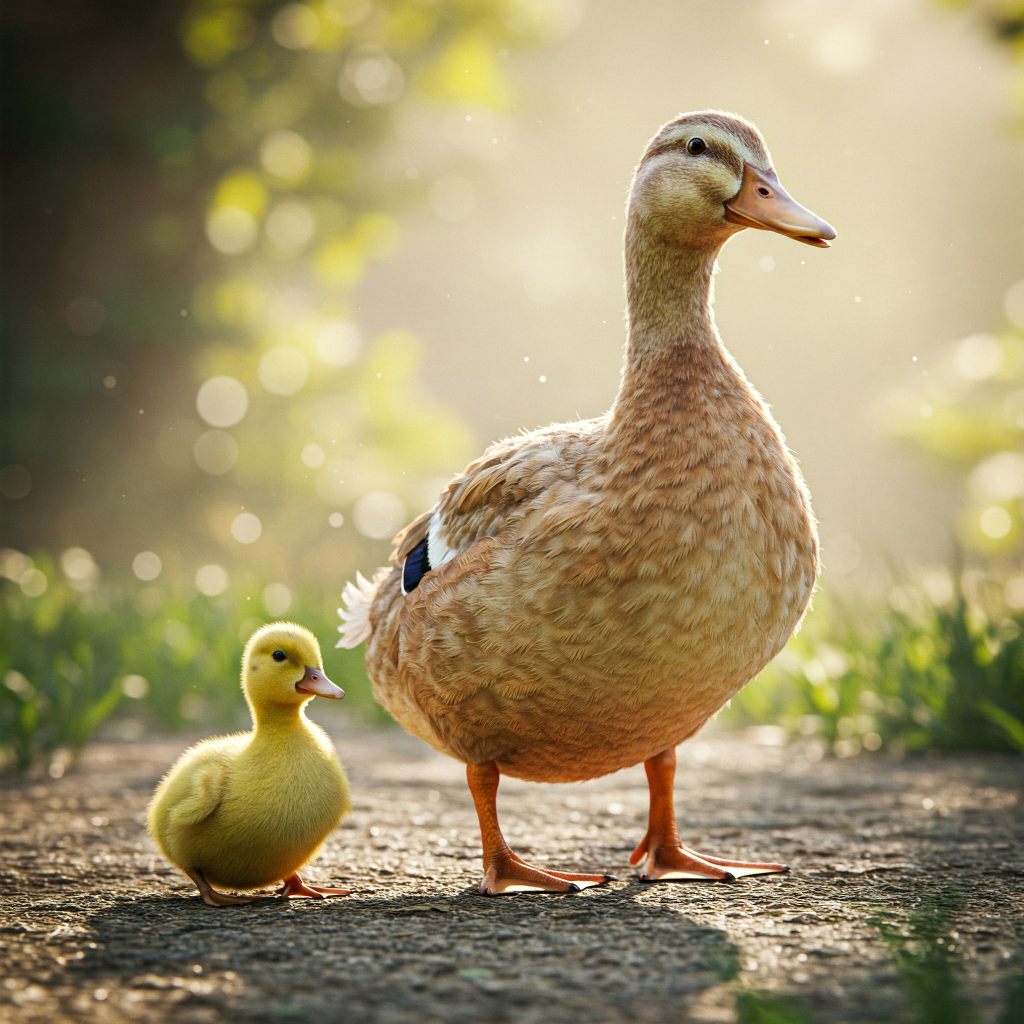
Identification:
- Ducklings: Long-bodied with upright postures, available in multiple colors.
- Adults: Tall, slender ducks that stand almost vertically.
Traits:
Indian Runner ducks are renowned for their egg production and quirky, energetic movements.
Fun Fact:
Runners are often described as “marathon ducks” due to their active nature.
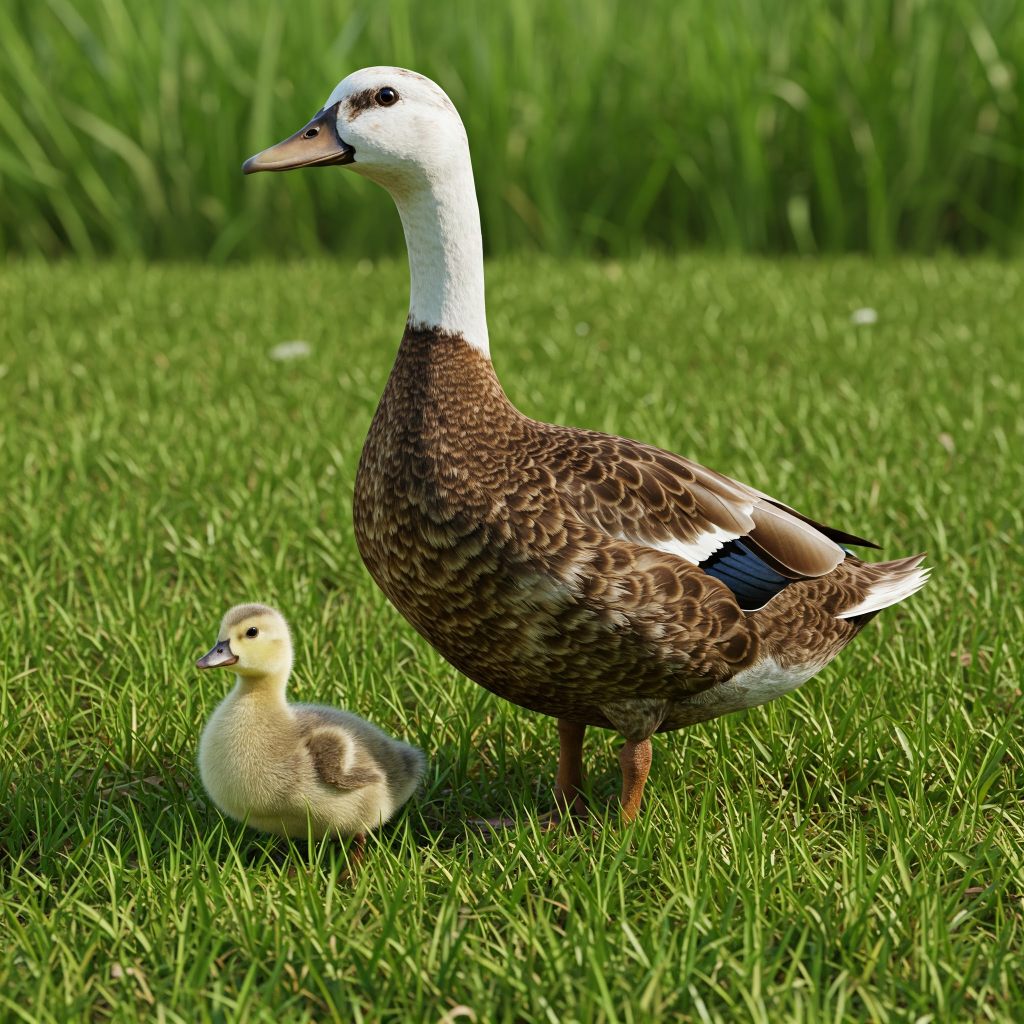
Indian Runner Ducklings and Ducks
- Identification:
- Ducklings: Upright stances, often in varied colors like black, white, or brown.
- Adults: Tall and slender with a penguin-like posture.
- Traits: Renowned for their egg production, Runners are active, efficient, and space-saving.
- Fun Fact: Indian Runners are so energetic, they’ve been nicknamed “the marathon runners” of the duck world.
16. Muscovy Ducklings and Ducks
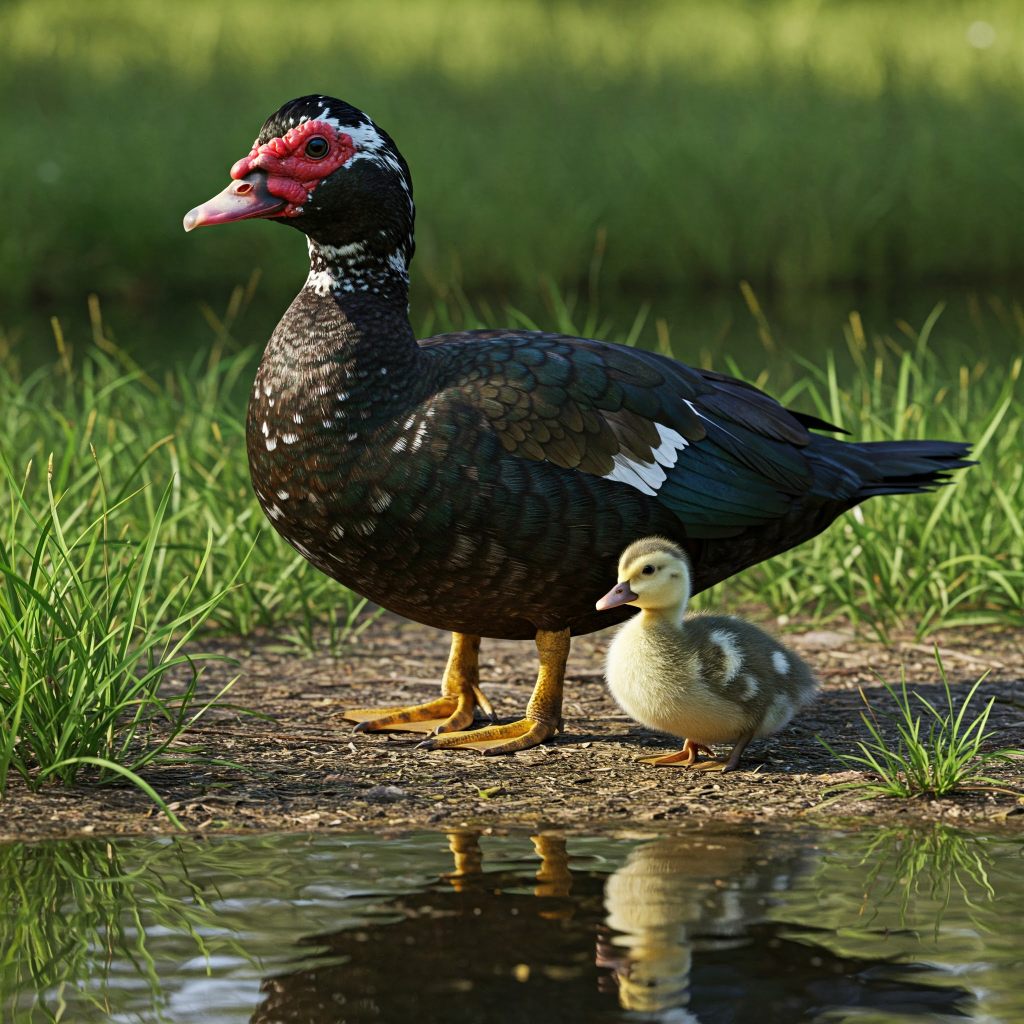
Identification:
- Ducklings: Often dark with patches of yellow or white.
- Adults: Red caruncles on their faces and various feather colors, including black and white.
Traits:
Muscovies are quiet, self-sufficient, and fantastic for pest control.
Fun Fact:
Unlike most ducks, Muscovies have clawed feet and perch in trees.
17. Appleyard Ducklings and Ducks
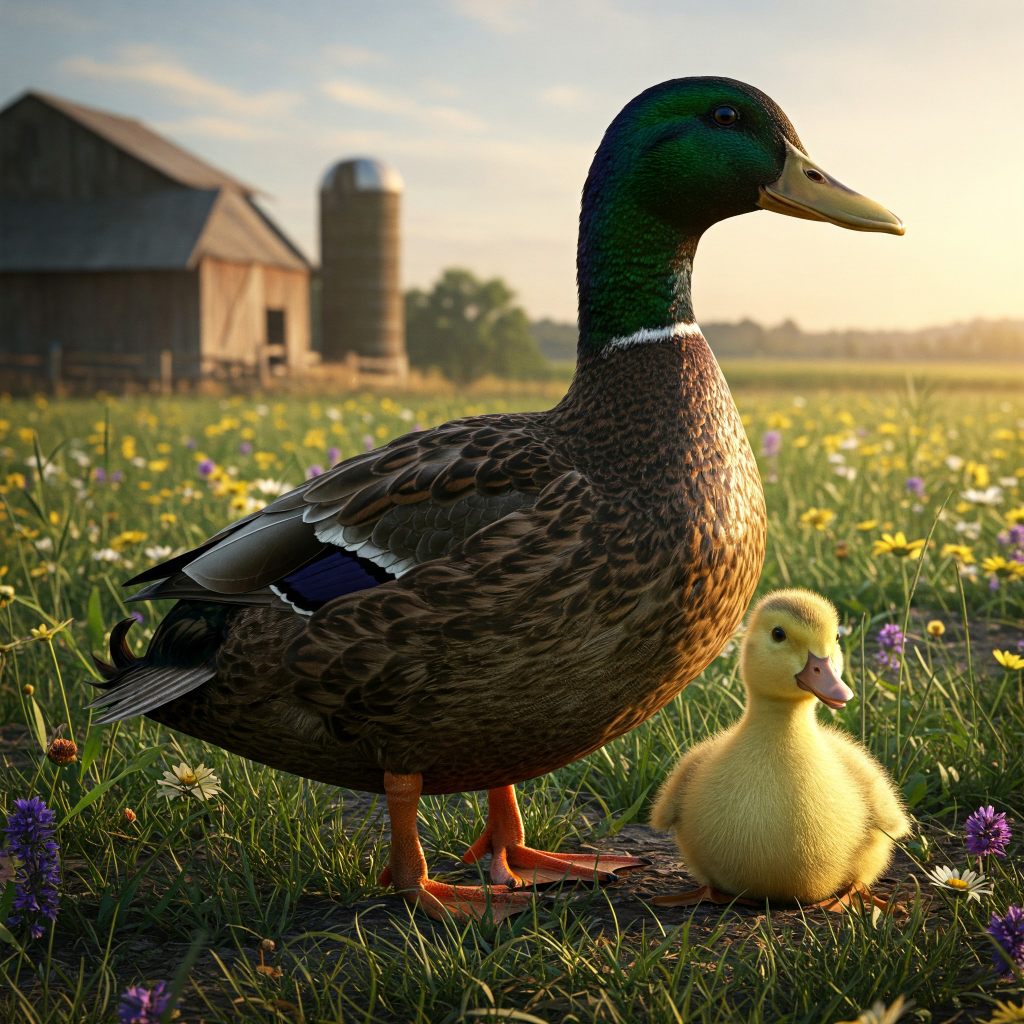
Identification:
- Ducklings: Yellow with brown markings, especially around the head.
- Adults: Silver plumage with rich brown and white patterns.
Traits:
Appleyards are productive dual-purpose ducks, offering both eggs and meat.
Fun Fact:
Reginald Appleyard bred this stunning duck in the 1940s for both beauty and utility.
18. Swedish Duck / Blue Swedish Duck

Identification:
- Ducklings: Swedish ducklings can emerge with blue-gray down or nearly black down intermingled with lighter patches, which sometimes results in a contrasting white bib.
- Adults: Often labeled as Blue Swedish ducks, they boast striking blue-gray feathers accented by white markings. Variations in plumage might produce either a deep blue or a softer, lighter tone.
Traits:
These ducks are robust, easy-going, and particularly suited for cooler, northern climates. They function well as egg layers and do well in ornamental roles because of the dramatic contrast of their plumage.
Fun Fact:
Due to a recessive gene controlling their signature coloration, not every Swedish duck offspring will sport the iconic “blue” tone, making each generation a delightful genetic lottery.
Leg Band and Color Identification of Day Old Ducklings
Identifying day-old ducklings by leg band or leg color can be a useful method for keeping track of different breeds or individual ducks within a flock. Here are some common methods for leg band and color identification in day-old ducklings:
1. Colored Leg Bands: You can use small, colored leg bands made of plastic or other safe materials. Each color can represent a different breed or individual duck. For example:
- Red bands for Pekin ducklings.
- Blue bands for Mallard ducklings.
- Yellow bands for Khaki Campbell ducklings.
2. Numbered Leg Bands: Another option is to use numbered leg bands. Assign a unique number to each duckling and keep a record of which number corresponds to which breed or individual. This method is helpful if you have a large number of ducklings.
3. Nail Polish: You can use non-toxic nail polish to paint a small spot on a duckling’s leg. Different colors or combinations of colors can represent different identifications. Make sure the nail polish is completely dry before returning the duckling to its brooder.
4. Leg Tape: Some breeders use colored electrical tape or medical tape to wrap around a duckling’s leg. This method is temporary and should be checked regularly to ensure it doesn’t become too tight as the duckling grows.
5. Permanent Marker: You can use a fine-tip, non-toxic permanent marker to make small marks or write codes on a duckling’s leg. This method is best for short-term identification as the markings may wear off over time.
Related FAQ’S
What Breed of Duck Is Yellow as a Duckling?
- Many duck breeds, including Pekin, Khaki Campbell, and Rouen, have yellow ducklings.
3. What Breed of Duck Is Black as a Duckling?
- The black coloration in ducklings is less common, but some duck breeds, such as the Cayuga, have black or very dark-colored ducklings.
4. What Kind of Duckling Is Black and Yellow?
- Ducklings that are black and yellow are typically a mix of breeds or hybrids. They can inherit coloration from both parent breeds, resulting in a combination of black and yellow feathers.
5. Are Black Ducks Female?
- The color of a duckling does not necessarily indicate its gender. In many duck breeds, both male and female ducklings can have similar coloration. To determine the gender of ducklings, you usually need to observe secondary sexual characteristics, such as bill shape, body size, and vocalizations, which become more apparent as the ducklings mature.
Summary
It’s important to note that while some ducklings may have specific color patterns associated with their breed, there can be individual variations, and color alone is not a reliable method for sexing ducklings. If you need to determine the gender of ducklings for breeding or other purposes, consider seeking guidance from an experienced duck breeder or a veterinarian.
When using any of these methods, it’s essential to prioritize the safety and comfort of the ducklings. Ensure that the leg bands or markings are not too tight and do not cause any discomfort or restriction as the ducklings grow. Regularly check and adjust the identification if needed. Additionally, keep a detailed record of the identification system you use to avoid confusion as the ducklings mature.

94% of pet owners say their animal pal makes them smile more than once a day. In 2007, I realized that I was made for saving Animals. My father is a Vet, and I think every pet deserves one. I started this blog, “InPetCare”, in 2019 with my father to enlighten a wider audience.
